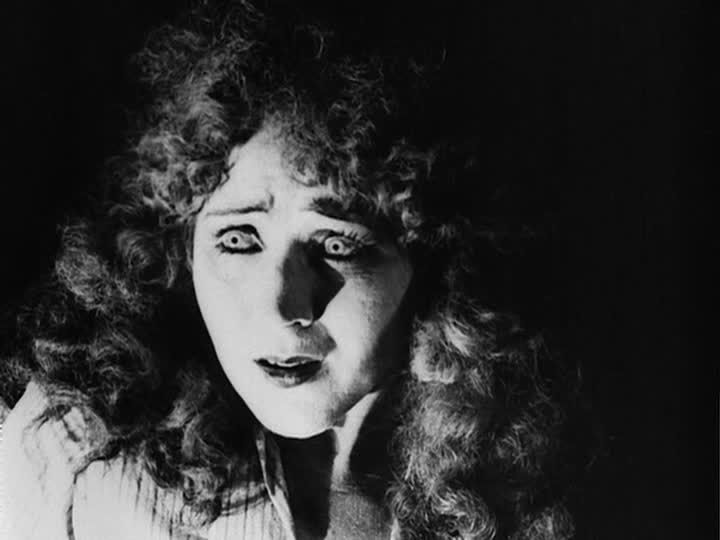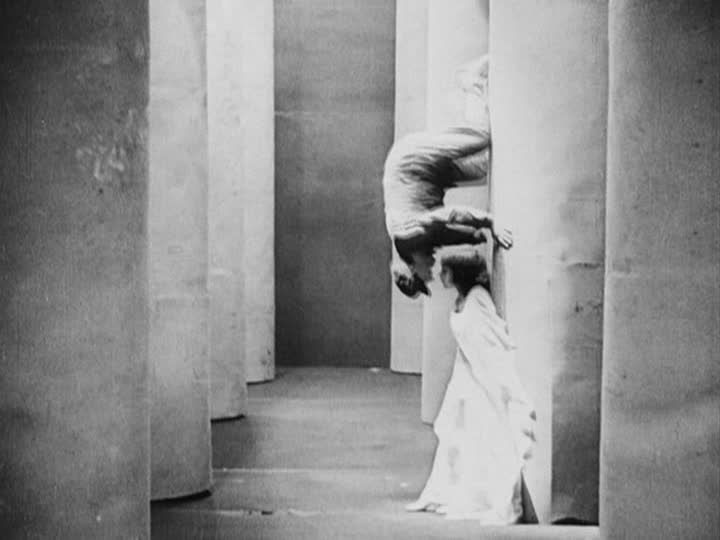
La fille de l'eau was Jean Renoir's first feature, the melodramatic story of young Gudule (Renoir's then-wife Catherine Hessling), whose father dies, her uncle (Pierre Lestringuez) abuses and attempts to rape her, and she's left on her own to endure a series of torments. After settling in with a group of gypsies, she's left on her own again when a conflict between the gypsies and the local farmers escalates into violence. She's then taken in by Georges (Harold Levingston), a shy young man who cares for her when she has nobody. Only the return of her drunken, nasty uncle threatens the happiness she finds with Georges and his family.
The story is fairly prosaic, and Hessling's dramatic range seems to be limited to staring at the camera with her admittedly striking eyes wide and her lips parted in an expression of terror or sadness, but there are definite signs of the director's talents in this very visually inventive debut. Some characteristic Renoir attributes are already in place here, like the naturalistic depiction of the picturesque countryside and the emphasis on class inequalities. This is especially apparent in the farmer Crepoix (Pierre Champagne), who begins harassing Gudule and the gypsies after Gudule's dog accidentally spills his bike. This petty, vindictive man physically assaults them and shatters their fishing traps, then brags about his exploits in town. Crepoix and the other farmers aren't even rich, but they're clearly at a higher social level than the nomadic gypsies, and with the exception of Georges' family, the townspeople lord this power over those beneath them.
What's really interesting about the film, though, is Renoir's inventive editing and aesthetics. At several points within the film, Renoir employs a jagged, rapid cutting style that feels surprisingly modern. In one scene, Gudule witnesses the burning of the gypsies' caravan before fleeing into the woods to escape from the angry townspeople. The next morning, she falls down a quarry, and Renoir cuts to a closeup of her face, surrounded by a frizzy halo of wild hair, followed by a rapid montage of very brief shots clipped from the previous night's torment, a subjective flashback montage that emphasizes how traumatic these images are for her. Each image lasts only a second or two, calling back the haunting nighttime images of flickering flames, the faces of the locals watching happily as the caravan is engulfed by fire. Later, when Gudule's uncle returns and she runs into him on the road, Renoir cuts rapidly back and forth from one face to another, a technique that recalls the much slower, tension-building approach he'd used in the earlier scene where the uncle nearly rapes Gudule. In that scene, too, Renoir had used alternating closeups, with the uncle gradually approaching, his face filling the frame, with the camera creeping closer and closer to Gudule as well, until her face was a blurry smear of terror. Renoir also highlights just the uncle's eyes in one shot, enclosing them in a rectangle within the frame, surrounded by black, calling attention to the act of looking, the act of looking at his niece with sexual predation.

Also very noteworthy is a long sequence in which the abandoned, feverish Gudule sleeps in the woods on a rainy night and has a strange, surreal dream that provides an opportunity for Renoir to indulge in the kind of hallucinatory visual effects that he often employed in his early silents. This is an extraordinary sequence in which Gudule drifts across the countryside, superimposed in ghostly, washed-out white, while encountering a barrage of surreal imagery. She runs across her uncle — suggestively holding a snake while leering at her — and Crepoix, and the two men appear as evil sprites haunting her throughout this dream. Renoir uses multiple superimpositions, runs the film backwards to make it seem as if Gudule is flying from the ground up into a sitting perch on a tree branch, and, in one unforgettable sequence, has the two men running across the frame sideways or upside-down from Gudule's perspective.
This unsettling, effects-laden dream sequence stands out here, anticipating the even more dazzling way in which Renoir would use this kind of surreal dream in his heartbreaking The Little Match Girl. Here, it's a momentary break in the low-key reality of this film, which drifts along without much bombast despite the melodramatic plot. This is an auspicious debut for Renoir, a film that's as attentive to the beauty of nature as it is to the plight of the heroine. This is especially obvious in the tranquil early scenes of the girl and her father on their riverboat, punctuated by evocative closeups of Gudule, her hair ruffled by the wind. Despite its predictable plot, La fille de l'eau is worthwhile for its union, uncharacteristic of later Renoir, of naturalistic photography with choppy editing flurries and fantastical optical effects.

2 comments:
The dream sequence is quite amazing. For years I was under the impression that it was all that survived of the film (I've seen it on two occasions presented as such), so I was interested to learn the whole film still survived... saw it in full for the first time about a year ago, and seeing that scene in context was interesting: not only was it the best part of the film, it was markedly unlike the rest of it as well. Very much as if Renoir was saying, "here, see what else I can do"...
Yeah the dream sequence stands out in a big way here. It's in line with some of Renoir's early, fantastical shorts like The Little Match Girl or Charleston Parade, both of which also experiment with effects and surrealism, like here. It's very cool to see him toying with this very unexpected style in these early films.
Post a Comment